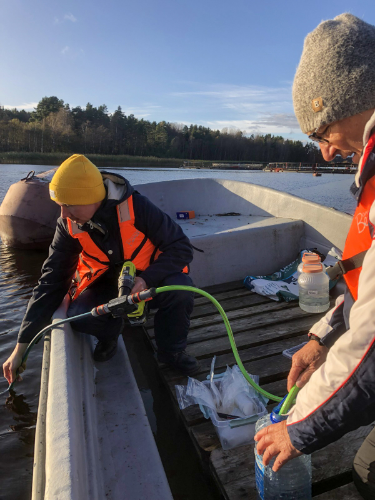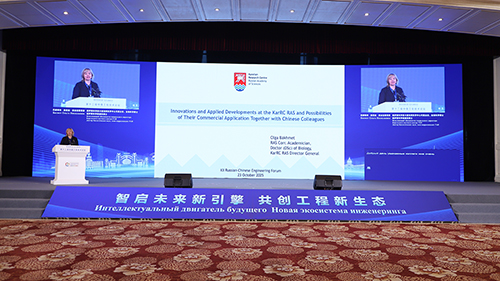Gyrodactylids (Gyrodactylus salaris) are flatworms of the Monogenea class, which are shorter than 2 mm. They infect the skin and gills of fish. G. salaris is not dangerous for humans, but its high abundance indicates the fish is in poor condition and likely also carrying other pathogens: bacteria or fungi that cause infectious diseases. In such circumstances, the gyrodactylids propagate actively and become the cause of a secondary disease - gyrodactylosis. The species being quite common, it was chosen as a model object for diagnosing the occurrence of the parasite in the water area and determining the sensitivity of the eDNA method.
Currently, for G. salaris to be detected, it is necessary to collect and examine biological samples – fish skin and gills. For the output to be reliable, the sample size should be around 15-20 fish. However, there is a method in world practice which helps determine fish infection by identifying the parasite's DNA in water. In particular, it has been actively used in Norway, where G. salaris has severely affected wild populations of Atlantic salmon. The method requires specialized equipment, including tools for special water filtration, sample preparation, DNA isolation, PCR analysis and the following sequencing, as well as selection of specific genetic markers.
The first part of the work was carried out in Karelia: scientists surveyed, season-wise, 9 trout farms in lakes Onego and Ladoga, in the catchment areas of these lakes and the White Sea. In addition to examining fish in the traditional way, water samples were taken to isolate environmental DNA. In the second stage, the samples were sent for genetic analysis to Moscow, to the Russian Federal Research Institute of Fisheries and Oceanography (VNIRO), which has the equipment and technology necessary for such analysis. The results were then compared.
– The results of the study of environmental DNA prove that the parasitic impact of the fish farming facility on the water area is not limited to the fish cages but extends hundreds of meters beyond them. The eDNA diagnostic system quite accurately reveals the presence of helminths of the genus Gyrodactylus in water. This method can be used for veterinary control in the fish farming industry, – summed up Aleksey Parshukov, Candidate of Biology, Senior Researcher of the Institute of Biology KarRC RAS, the research leader.
This technique can also be applied for ecological monitoring of natural water bodies.
– With evidence of the presence of certain organisms in the water at hand, we can document the fact of anthropogenic impact. We will have the grounds to claim that the parasite is not there naturally, but is associated with trout farms in this water area, and then it will be necessary to deal with the primary source: to make the farms control the epizootic status and create conditions to prevent the pathogen from spreading, – noted Evgeny Ieshko, Doctor of Biology, Principal Researcher of the Institute of Biology KarRC RAS.

Fieldwork. Aleksey Parshukov, Senior Researcher of IB KarRC RAS, and Evgeny Ieshko, Principal Researcher of IB KarRC RAS, in the frame
However, the eDNA system cannot be immediately adopted into practice in the republic: it will take time and additional provision of equipment and reagents to complete all stages of the research cycle, starting with sample preparation and culminating in bioinformatic data processing.
Overall, the research project produced results important for basic science as well as for practical purposes. In particular, examination of the fish samples revealed a species new for the region – Gyrodactylus teuchis. It is a widespread parasite of wild and cultured salmonid fishes all over Europe. It has not been encountered in Karelian fish farms before. Here, only Gyrodactylus salaris had been known, more specifically its clone G. salaris RBT, which infects cage-reared trout.
– It is for the first time that the monogenean G. teuchis has been found on cage-reared rainbow trout in the Onego catchment or the two species found co-occurring on one host individual. Most likely, the parasite has been transported to the area with fish stock and has already dispersed widely over the region. Monogeneans G. teuchis are not pathogenic for trout in aquaculture or for wild juvenile salmon populations, but the very fact of their dispersal signals that the veterinary control of the fish stock brought over to the area is inadequate, – stated Aleksey Parshukov.
The finding has provided an opportunity to additionally study the haptoral morphology of G. teuchis. The results of the study were published in the Russian Journal of Parasitology. In particular, scientists have confirmed the correlation between the ambient temperature and the size of the hooks with which the parasites attach to the host: they are smaller in summer, because when it is warm, the monogeneans accelerate the embryogenesis rate and have no time to develop their sclerites to full size.
Photos from archives of the research participants





